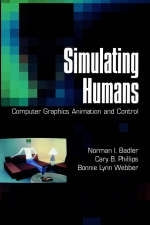
Simulating Humans
Oxford University Press Inc (Verlag)
978-0-19-507359-1 (ISBN)
Though actively pursued by several research groups, the problem of providing a synthetic or surrogate human for an engineer or designer already used to Computer Aided Design techniques has been most comprehensively solved by Norman Badler's computer graphics laboratory at the University of Pennsylvania - one of the world leaders in the field of simulated human figures in computer graphics. For human factors engineers, this book provides current knowledge of how a computer graphics surrogate human can augment their analyses of designed environments; for design engineers it presents the cutting edge in human figure modelling and hence human-centred design and for the computer graphics community it presents a major research effort in the interactive control of articulated human figures. This book constitutes the state of the art in simulating human figures, discusses the many areas of application and predicts the future in this exciting, fast moving field.
1. Introduction and Historical Background ; 1.1 Why make human figure models? ; 1.2 Historical roots ; 1.3 What is currently possible? ; 1.4 Manipulation, animation, and simulation ; 1.5 What did we leave out? ; 2. Mody Modeling ; 2.1 Geometric body modeling ; 2.2 Representing articulated figures ; 2.3 A flexible torso model ; 2.4 Shoulder complex ; 2.5 Clothing models ; 2.6 The anthropometry database ; 2.7 The anthropometry spreadsheet ; 2.8 Strength and torque display ; 3. Spatial Interaction ; 3.1 Direct manipulation ; 3.2 Manipulation with constraints ; 3.3 Inverse kinematic positioning ; 4. Behavioral Control of Articulated Figures ; 4.1 An interactive system for postural control ; 4.2 Interactive manipulation with behaviors ; 4.3 The animation interface ; 4.4 Human figure motions ; 4.5 Virtual human control ; 5. Simulation with Societies of Behaviors ; 5.1 Forward simulation with behaviors ; 5.2 Locomotion ; 5.3 Strength guided motion ; 5.4 Collision-free path and motion planning ; 5.5 Posture planning ; 6. Task-level Specifications ; 6.1 Performance simulation with simple commands ; 6.2 Natural language expressions of kinematics and space ; 6.3 Task-level simulation ; 6.4 A framework for instruction understanding ; 7. Epilogue ; 7.1 A road map toward the future ; 7.2 Conclusion
| Erscheint lt. Verlag | 2.9.1993 |
|---|---|
| Zusatzinfo | halftones, line illustrations |
| Verlagsort | New York |
| Sprache | englisch |
| Maße | 163 x 235 mm |
| Gewicht | 612 g |
| Themenwelt | Informatik ► Theorie / Studium ► Künstliche Intelligenz / Robotik |
| Informatik ► Weitere Themen ► CAD-Programme | |
| ISBN-10 | 0-19-507359-2 / 0195073592 |
| ISBN-13 | 978-0-19-507359-1 / 9780195073591 |
| Zustand | Neuware |
| Haben Sie eine Frage zum Produkt? |
aus dem Bereich


